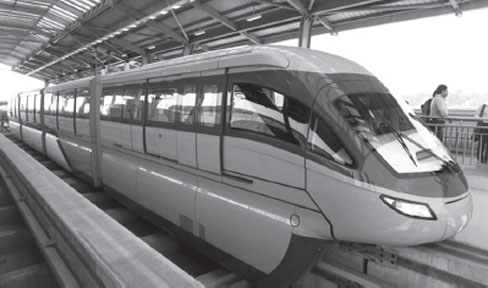The much-awaited Mumbai monorail, India’s first, was thrown open to the public in February 2014, ending the city’s wait for a new mode of public transport. However, less than three months after its launch, serious doubts are being raised about its utility.
Monorails are public transport vehicles which run on single tracks, as against the common double tracked trams, railways, and can be at grade, i.e on ground, underground or elevated. Proponents of monorails argue that the advantage of monorail is that the traction rail is half, both in cost and material, and hence economical. But there’s the rub.
In regular railway systems, the tracks are all connected, the alignment fixed by the sleepers or ties, and the entire arrangement is supported on the metal ballast. In contrast, the commonly used elevated monorail is supported on a very heavy reinforced cement concrete beam, and the vehicle runs with rubber tyres on it.
It is widely accepted that the Mumbai Metropolitan Region Development Authority (MMRDA) decided to implement the monorail, ostensibly as a feeder service to cater to crowded and narrow congested areas of the city. In reality though the Mumbai monorail, runs on quite a sparsely travelled route.
But seriously, the Mumbai monorail is extremely lacking in capacity, even if they manage the most optimum headway between services. And that is itself a moot point, since there should be enough demand to enable it to succeed. At present, the services are only from Chembur to Wadala, which are running in huge losses. MMRDA officials attribute it to poor feeder services at Wadala, and to cover up its poor planning, MMRDA says one needs to wait till the entire set up is in place.
This huge facility, with construction going on since six years or more, has already cost over a thousand crores, and the expenses will be at least three times more for the rest of the stretch, not to mention operations, regular and routine maintenance and repair cost per month.
For the same investment, Mumbai could have got around 3000 air-conditioned deluxe buses like Volvo or Mercedes, and commensurate smaller ones for the narrower streets and lanes. Such buses would have had the flexibility of being operated singly or in multiple units, which would have so many advantages over this elevated monorail.
For one, it is going to be very difficult to see passengers keep going up and down every day, twice a day for this type of ride. Such enormous investments could have been better utilised with a much clearer action plan for public transportation in Mumbai, and for that matter in all the other urban areas where monorails and metro rails are being built and developed.
A downside of these overhead structures like monorails and metro rails, which are as good as permanent, is that they virtually block the city’s landscape and give absolutely no scope for having more lines in different directions, because by default they follow the road carriageway route either by the side of it, or above and along the median.
Further, while the average speed for road traffic is said to be around 17 kmph, the average speed for monorail will be at best 31 kmph, not at all significant when we consider that the passengers have to go up and down, then get to the monorail station by autorickshaw or taxi or bus or foot, and same way at the destination. In a good multi-modal transport system, change overs from one mode to another have to be smooth, if not seamless. Here, the situation is not at all like that. Over all, the monorail is hardly something which will radically change commuting in Mumbai.
At present, the bus services are hardly coordinated and synchronised with the monorail or metro, as it ought to have been. The stations do not have drinking water facilities or even seating arrangements. One could say that monorail in its present form is an ill-conceived system that has been forced on the city of Mumbai, just to show that the city has a monorail, in addition to a metro.


